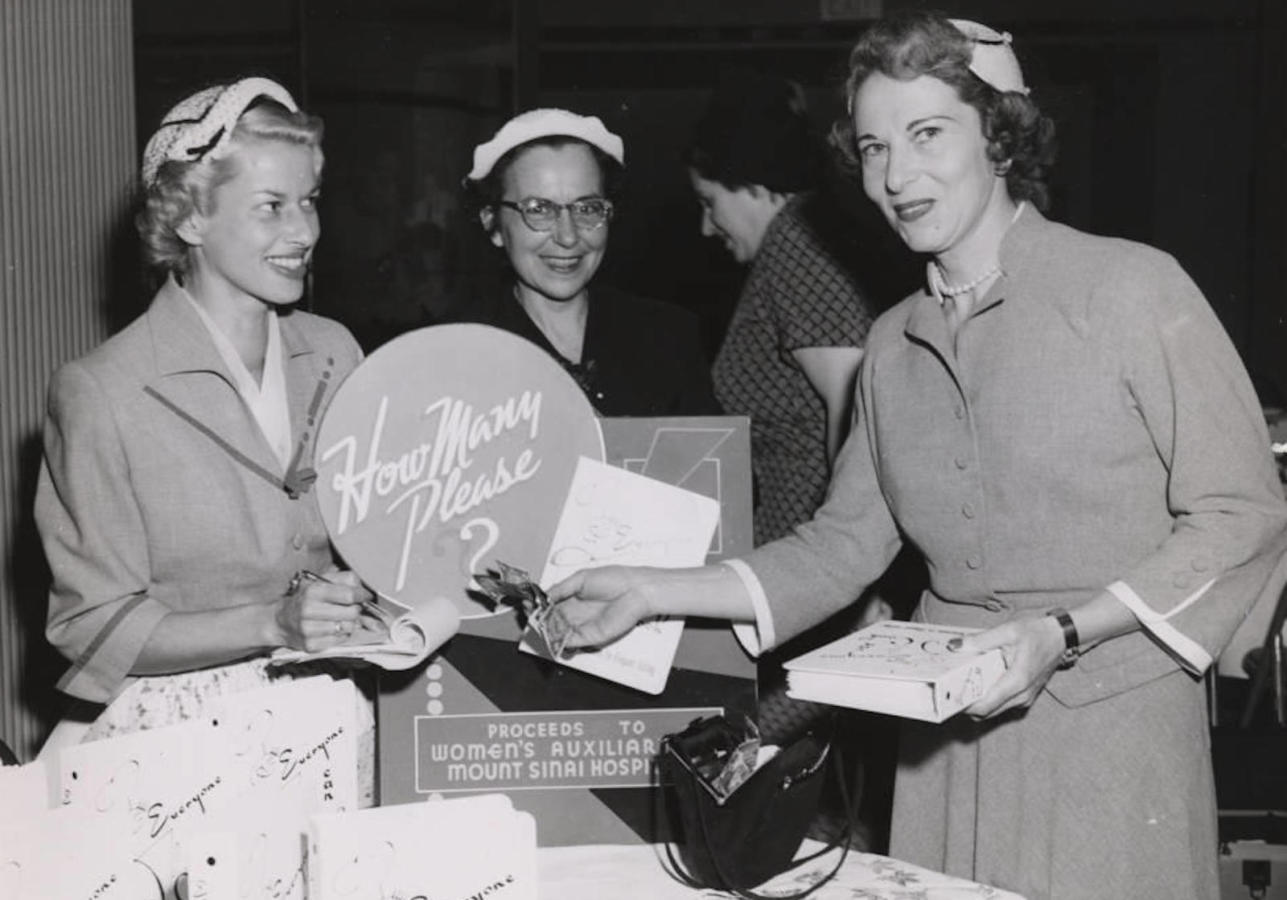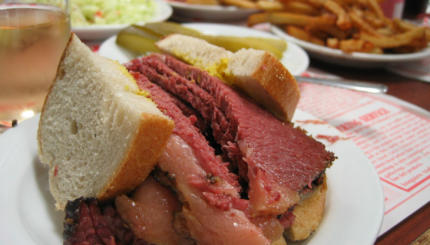What’s big and long and in some places? The history of Jewish cookbooks. Long before the Joy of Cooking was published in 1936, Jewish women were writing and sharing their recipes and food traditions. Filled with recipes from gefilte fish to oyster canapés to dafina, Jewish cookbooks were the single-largest form of writing by and for Jewish women. These cookbooks offer a revealing glimpse into the everyday lives of Jews, and the range of cultural practices and religious customs in the modern period.
What Makes A Cookbook Jewish?
A Jewish cookbook is a collection of recipes in some way associated with Judaism and/or Jewish people. Commonly divided into three categories: promotional, community (or charitable) and individually authored, Jewish cookbooks may be brimming with traditional Jewish recipes or lacking in all but a few.
Find recipes and Jewish food news on The Nosher, our lively food site.
Promotional cookbooks are published by food companies with recipes that call for their products. Manischewitz, for example, published Tempting Dishes (1930) featuring advertisements for their products placed between kosher-for-Passover recipes such as Strawberry Shortcake. Meanwhile, Procter and Gamble promoted its Crisco oil to Jewish women in its cookbook, Crisco Recipes for the Jewish Housewife, first published in back-to-back Yiddish and English in 1933.

Help us keep Jewish knowledge accessible to millions of people around the world.
Your donation to My Jewish Learning fuels endless journeys of Jewish discovery. With your help, My Jewish Learning can continue to provide nonstop opportunities for learning, connection and growth.
Jewish community cookbooks are fundraising endeavors compiled to collect funds for a Jewish organization (e.g., Hadassah, ORT), a synagogue, or other charitable causes. Jewish community cookbooks have been published in cities, towns, and suburbs all across North America. Although publication runs for individually authored cookbooks are often larger, Jewish community cookbooks represent the greatest number of Jewish cookbooks published.
Jewish cookbooks penned by one author, often a food or nutrition expert of some sort, are published by commercial publishing houses, both secular and Jewish, and geared for large audiences.
Going Back in Time
The first bound volume of Jewish recipes emerged from the German city of Carlsruhe in 1815, but the most successful early Jewish cookbook was Rebekka Wolf’s Kochbuch fuer Israelitische Frauen (Cookbook for Jewish Women) (Berlin, 1856), which went through 14 editions in several languages. The first English-language Jewish cookbook emerged in London, The Jewish Manual, or Practical Information in Jewish and Modern Cookery (1846).
As Barbara Kirshenblatt-Gimblett has shown, by the end of the 19th century, gourmet kosher cookbooks appeared across Europe and served as common gifts for young brides. Fifty years later, European Jewish cookbooks took on a new flavor, highlighting regional specialties or political and philanthropic causes, such as those of the Juedischer Frauenbund, the German Jewish feminist organization.
Esther Levy wrote the first American Jewish cookbook, Jewish Cookery Book on Principles of Economy Adapted for Jewish Housekeepers with Medicinal Recipes and Other Valuable Information Relative to Housekeeping and Domestic Management (Philadelphia: 1871). As immigration from Eastern Europe began en masse, Yiddish cookbooks also began to appear in the United States, such as Hebrew Publishing Company’s Dos familyen kokh-bukh (The Family Cookbook) (New York: 1914). With recipes for apple pie and other American favorites, these cookbooks in part acted as early tools of integration, providing traditional recipes for gefilte fish alongside American classics.
Meanwhile, “Aunt Babette’s” Cook Book, an early and exceptionally popular cookbook first published by Bloch Publishing Company in 1889 (Cincinnati) — with dozens of editions thereafter — offered lengthy instructions on gourmet cuisine and fashionable table setting. Bloch released several follow-ups to Aunt Babette’s (a pseudonym for Bertha Kramer), including in 1945 The Jewish Cookbook (revised and enlarged in 1958), by dietician Mildred Grosberg Bellin. With non-kosher recipes such as “Oysters Baked on Shell,” Aunt Babette’s reflected the Reform community from which it emerged.
Community Collections
This Germanic or Anglo-oriented community in the United States also produced the first Jewish community cookbooks of the early 20th century. Although these cookbooks rarely demonstrated adherence to , they raised funds for synagogues or explicitly Jewish causes such as the Hebrew Sheltering Guardian Society of New York Orphan Asylum (The Auxiliary Cook Book, 1909).
Cookbooks, such as The Practical Cook Book (c. 1910) contained recipes compiled by the Sisterhood of the West End Synagogue in New York City, featured dishes such as Lobster à la Newburg, Roast Beef with Yorkshire Pudding, and lebkuchen, as well as chapters devoted to Passover and menus for “Washington’s Birthday Luncheon.”
Treyf or Kosher
While the audience for each charitable cookbook was often limited to the community or city in which it was published, The Settlement Cookbook and later The Jewish Home Beautiful represent two major exceptions to this rule. First published in 1901 by Lizzie Black Kander, The Settlement Cookbook raised funds for recent Jewish immigrants in Milwaukee.
One of the most popular Jewish cookbooks of all time, 40 editions and nearly two million copies of The Settlement Cookbook have been sold. Like other early 20th-century Germanic-oriented Jewish cookbooks, this cookbook called for butter with meat, and routinely listed treyf ingredients such as shrimp and lobster.
In contrast, The Jewish Home Beautiful was produced with the intention of inspiring Jewish ritual observance by heightening attention to the aesthetics of the Jewish table and ceremony (e.g., paired cheese blintzes dusted with 10 lines of cinnamon to represent the Ten Commandments for a Shavuot table). This wildly popular cookbook was first published in 1941 by the Conservative movement‘s United Synagogue of America and reached its ninth edition by 1958.
In the post-World War II era, the publication of community cookbooks proliferated, owing in part to the advent of micropublishing as well as the exponential growth of the Jewish community in the US, where the greatest number of community cookbooks — and Jewish cookbooks in general — have been published.
Among the thousands of postwar community cookbooks, a range of practices appear from little explicitly Jewish content to strict adherence to Jewish ritual observance. For example, A Peek Into Our Kitchens, a cookbook compiled by the Boston chapter of National Council of Jewish Women in 1954, features traditionally Jewish recipes such as kreplach and tzimmes, yet dishes also found in the volume include Beef with Sour Cream and Shrimp Creole.
In what would become the State of Israel, Jewish cookbooks began to appear as early as 1936, with Erna Meyer’s German-language cookbook for recent immigrants to the country. Ruth Sirkis’ cookbook Mehamitbah Beahava (From the Kitchen with Love) achieved canonical status in Israel since its publication in 1975. More recently Israeli cuisine has been marketed abroad with glossy cookbooks such as Janna Gur’s The Book of New Israeli Food: A Culinary Journey (2008).
In Israel and in the Diaspora, ethnic cuisines form the basis of many Jewish cookbooks published in the last third of the 20th century, with titles from Greek, Indian, and Yemenite communities, for example. Cookbooks geared to Orthodox Jews also began to appear during this period, including fundraising cookbooks for the Chabad Lubavitch community, and Deal Delights, a cookbook now in its third edition since first appearing in 1976 by the Women’s Organization of the Jersey Shore.
By the turn of the 21st century, a number of Jewish cookbook authors, such as Susie Fishbein of ArtScroll’s Kosher by Design series, had large followings not unlike their historic counterparts, while the Internet had made recipe sharing instantaneous. A number of comprehensive cookbooks traversing the Jewish world have also appeared from chef/authors such as Joan Nathan, Gil Marks and Claudia Roden — ensuring that the diversity and history of Jewish cuisine may be replicated in any kitchen today.
Find recipes and Jewish food news on The Nosher, our lively food site.



